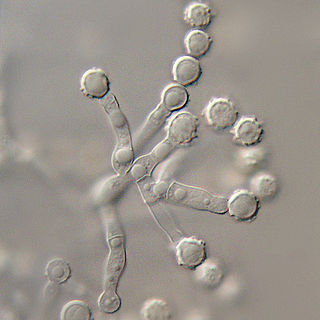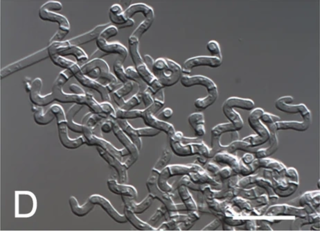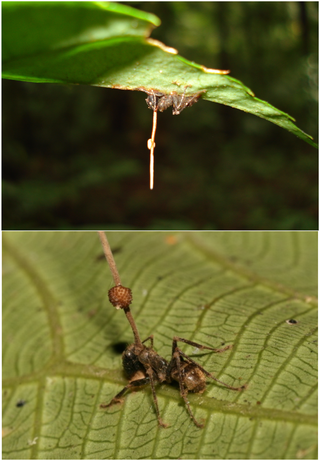
The Eurotiales are an order of sac fungi, also known as the green and blue molds. It was circumscribed in 1980.

The Hypocreales are an order of fungi within the class Sordariomycetes. In 2008, it was estimated that it contained some 237 genera, and 2647 species in seven families. Since then, a considerable number of further taxa have been identified, including an additional family, the Stachybotryaceae. Wijayawardene et al. in 2020 added more families and genera to the order. According to the Catalog of Life, As of April 2021 the Hypocreales contains 6 families, 137 genera, and 1411 species. Hyde et al. (2020a) listed 14 families under Hypocreales, while, Wijayawardene et al. (2022) accepted 15 families in the order, where Cylindriaceae was additionally added. Earlier, Hyde et al. (2020a) had placed Cylindriaceae in class Xylariomycetidae. Samarakoon et al. (2022) agreed. Hence, Cylindriaceae should have been excluded from Hypocreales and placed in Xylariomycetidae. Xiao et al. (2022) recently introduced a new family Polycephalomycetaceae to Hypocreales.

Neurospora is a genus of Ascomycete fungi. The genus name, meaning "nerve spore" refers to the characteristic striations on the spores that resemble axons.

The order Sordariales is one of the most diverse taxonomic groups within the Sordariomycetes.

The Microascaceae are a family of fungi in the class Sordariomycetes, subclass Hypocreomycetidae. The family was published by David Malloch in 1970, an emended description based on Everet Stanley Luttrell's original 1951 publication. Family was updated in 2020.

Microascus is a genus of fungi in the family Microascaceae.
Kernia is a genus of fungi in the family Microascaceae.
Apodospora is a genus of fungi, formerly within the Lasiosphaeriaceae family. As on 2020, it was placed in the Bombardiaceae family.
Cercophora is a genus of fungi which was within the Lasiosphaeriaceae family. As of 2020, it was placed into the Neoschizotheciaceae family.

Podospora is a genus of fungi in the family Podosporaceae. Fossils of Podospora have been reported from 12 million year old rocks from central England.
Zopfiella is a genus of fungi within the Lasiosphaeriaceae family.

Arachnomyces is a genus of cleistothecial ascomycete fungi described in 1902, of which the anamorph (asexual) stage is the genus Onychocola. Although morphologically similar to members of other families, the fungus now belongs to its own monotypic family Arachnomycetaceae, which is the only family in the monotypic order Arachnomycetales.
Emericellopsis is a genus of fungi in the order Hypocreales. The relationship of this taxon to other taxa within the order is unknown, and it has not yet been placed with certainty into any family.

Ophiocordycipitaceae is a family of parasitic fungi in the Ascomycota, class Sordariomycetes. It was updated in 2020.
Trichocladium is a genus of fungi within the Chaetomiaceae family.
Thermoascus is a genus of soil fungi in the family Trichocomaceae. Species in the genus are characterized by the production of heat-resistant ascospores. Thermoascus was circumscribed by German botanist Hugo Miehe in 1907.
Triangularia setosa is a member of the Ascomycota, and of the genus Triangularia. This genus is notable for its widespread appearance on the excrement of herbivores, and is therefore seen as a coprophilous fungus. The fungus itself is characteristically dark in colour and produces sac-like perithecium with a covering of hair. Its dispersion involves the ingestion, passage, and projectile ejection of spores. It has preference for colonizing the dung of lagomorphs, such as hares and rabbits.
Collariella is a genus of fungi in the family Chaetomiaceae.
Humicola is a genus of fungi belonging to the family Chaetomiaceae.







